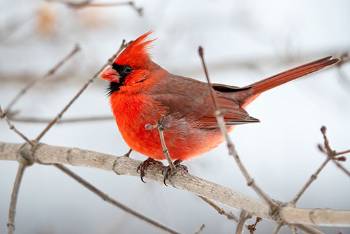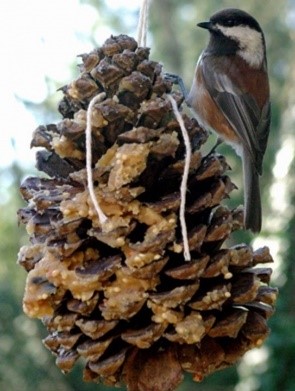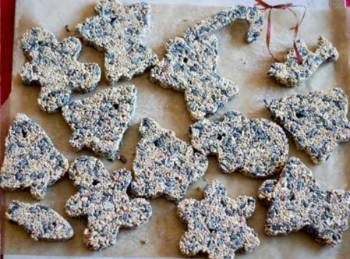Feeding the Birds

As cooler weather has set in, many of us look forward to feeding and watching the birds throughout the winter months. There is little as cheerful in the winter as a brilliant red Cardinal on a feeder, even on a snowy, dreary day. While it might seem easy, just put out food and they will come, there is more to feeding the birds than that. Here are some tips to bring birds to your yard and feeders over the winter.
- Picking the food- As you stand in the bird food aisle, it can be an overwhelming display of different types of seeds, mixes, and even other forms of bird food. It's no wonder it can be overwhelming to have over 20 different types of bird seed on the market at any time, and no one seed is attractive to all birds. The best all-around seed option is Black oil sunflower seed. While it might be more expensive, it is preferred by many small birds because of its thinner seed coat and high oil content, which are important nutritionally for birds in winter. Other popular options include thistle seed, which attracts goldfinches and purple finches, and millet seed, which attracts a variety of birds, including sparrows and peanuts (either whole or the "hearts") that attract Blue jays, woodpeckers, and others. Your best bet is to use a mix of seeds and a variety of different feeders to attract the widest variety of species. A reminder: with birdseed, you get what you pay for. Some cheaper mixes have less desirable seeds that the birds won't eat. Another option is Suet, which is attractive to a variety of birds. Suet is a high-quality animal fat that is highly sought-after in winter. It is beautiful to woodpeckers, chickadees, nuthatches, and titmice, although some atypical feeder birds like Carolina wrens and brown creepers also like it.
- Location, Location, Location- When placing your feeders, consider them from your and the bird's
 perspectives. My best luck feeding the birds has been in a house where I had protective cover within 10 feet of my feeders (shrubs, trees, etc.) for the birds to hide from predators in and in view of my living room windows for my enjoyment. If you don't have much for cover in your yard, my new house has very little in the way of cover at this point; you can create it, especially after Christmas, using discarded trees. If you have the option, consider developing cover using trees and shrubs over the next growing season.
perspectives. My best luck feeding the birds has been in a house where I had protective cover within 10 feet of my feeders (shrubs, trees, etc.) for the birds to hide from predators in and in view of my living room windows for my enjoyment. If you don't have much for cover in your yard, my new house has very little in the way of cover at this point; you can create it, especially after Christmas, using discarded trees. If you have the option, consider developing cover using trees and shrubs over the next growing season. - Don't forget to have a place for the birds to get water and food in your yard. Winter months can mean a time of drought for birds, but a bird bath with a heater can solve that issue. Water will be very attractive to your birds in the winter. Place your water underneath or near branches so the birds have places to preen after bathing.
There are also some inexpensive bird feeders you can make at home. The first bird feeder, using pine cones and peanut butter, is an old favorite that is cheap and easy to make. Growing up, this was one of my favorite easy feeders to make and hang on our Christmas tree outside. The first step is to use string, wire, or a pipe cleaner to make a hanger by wrapping it around the top or bottom of the pine cone. (I say this is the first step because it can get messy if you try to do this after you’ve done the peanut butter and birdseed. I might have some personal experience with it, oops). Then, spread a generous layer of peanut butter over the pine cone; if you have peanut allergies, Crisco softened works well for this step as a replacement for peanut butter. Roll the cone in birdseed; smaller seeds work best until the cone is completely covered. Hang outside in a tree, bush, or on a hook. Just remember to keep them close to trees or other shelter for the birds to hide from predators.

The second bird feeder is new, but it will look cool on an old Christmas tree. Bird Seed Cookies are simple to make and only use a few ingredients:
- 2 cups birdseed (any type)
- cookie cutters
- 1 packet of unflavored gelatin
- 2 tablespoons cold water
- 1/3 cup boiling water
- string
- skewer
- non-stick cooking spray
Instructions:
- Spray your cookie cutters with non-stick spray to make the cookies easier to pop out.
- Empty one package of unflavored gelatin into a bowl with two tablespoons of cold water. Let this sit for one minute. Add 1/3 cup of boiling water to the gelatin, stirring for a few minutes or until the gelatin is dissolved. This is the binder that keeps seeds together.
- Next, mix two cups of birdseed with the gelatin.
- Lay out your cookie cutters on a tray or sheet of wax paper. Fill the cookie cutters with the mixture and press into shape firmly. Make a small hole in each cookie with the skewer for the string.
- Place in the refrigerator for a few hours to allow the seed mixture to set. Carefully pop the cookies from their molds and thread a string through the hole.
Feeding the birds can be a fun activity for people of all ages. I can’t wait to make different feeders with my son this winter and hang them in the backyard. Whatever bird feeder you decide to use or make this winter, be sure to provide our feathered friends some water along with their food, especially if the weather remains dry this winter. Our bird friends will thank you with their happy songs and fun-to-watch antics throughout the winter months.

Have questions? Contact our office where our Horticulture Extension Agent will assist you with questions.
Phone: (316) 321-9660
Email: callae@ksu.edu